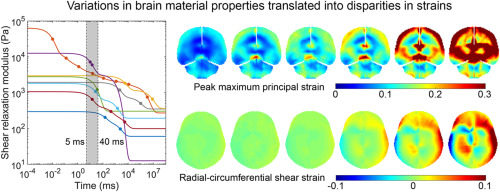Journal of the Mechanical Behavior of Biomedical Materials ( IF 3.3 ) Pub Date : 2018-02-06 , DOI: 10.1016/j.jmbbm.2018.02.005 Wei Zhao , Bryan Choate , Songbai Ji

|
Material properties of the brain have been extensively studied but remain poorly characterized. The vast variations in constitutive models and material constants are well documented. However, no study exists to translate the variations into disparities in impact-induced brain strains most relevant to brain injury. Here, we reviewed a subset of injury-relevant brain material properties either characterized in experiments or adopted in recent head injury models. To highlight how variations in measured brain material properties manifested in simulated brain strains, we selected six experiments that have provided a complete set of brain material model and constants to implement a common head injury model. Responses resulting from two extreme events representing a high-rate cadaveric head impact and a low-rate in vivo head rotation, respectively, varied substantially. We hypothesized, and further confirmed, that the time-varying shear moduli at the appropriate time scales (e.g., ~5 ms and ~40 ms corresponding to the impulse durations of the major acceleration peaks for the two impacts, respectively), rather than the initial or long-term shear moduli, were the most indicative of impact-induced brain strains. These results underscored the need to implement measured brain material properties into an actual head injury model for evaluation. They may also provide guidelines to better characterize brain material properties in future experiments and head injury models. Finally, our finding provided a practical solution to satisfy head injury model validation requirements at both ends of the impact severity spectrum. This would improve the confidence in model simulation performance across a range of time scales relevant to concussion and sub-concussion in the real-world.
中文翻译:

与伤害有关的条件下大脑的物质特性–实验和计算模型
大脑的物质特性已被广泛研究,但特征仍然很差。本构模型和材料常数的巨大差异已得到充分记录。但是,尚无研究将这种变化转化为与脑损伤最相关的撞击诱发的脑部应变的差异。在这里,我们回顾了与损伤有关的脑材料特性的子集,这些子集要么在实验中表征,要么在最近的颅脑损伤模型中采用。为了突出在模拟的脑部应变中所测得的脑部材料特性的变化,我们选择了六个实验,这些实验提供了一套完整的脑部材料模型和常数,以实施常见的颅脑损伤模型。由两个极端事件引起的响应,分别代表高比率的尸体头部撞击和低比率的体内头部旋转分别显着变化。我们假设并进一步证实,在适当的时标(例如,分别对应于两次撞击的主要加速度峰值的脉冲持续时间的〜5 ms和〜40 ms)的时变剪切模量,而不是初始或长期剪切模量最能说明撞击引起的脑部劳损。这些结果强调了将测得的大脑物质特性实施到实际的颅脑损伤模型中进行评估的必要性。它们还可以提供指导方针,以在将来的实验和头部损伤模型中更好地表征大脑物质的特性。最后,我们的发现提供了一种实用的解决方案,可以满足冲击严重性谱两端的头部损伤模型验证要求。











































 京公网安备 11010802027423号
京公网安备 11010802027423号